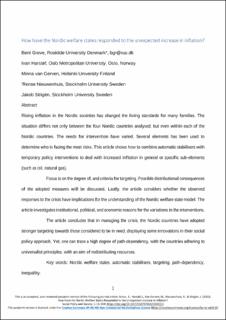How Have the Nordic Welfare States Responded to the Unexpected Increase in Inflation?
Peer reviewed, Journal article
Accepted version
Permanent lenke
https://hdl.handle.net/11250/3097972Utgivelsesdato
2023Metadata
Vis full innførselSamlinger
- Publikasjoner fra Cristin [3269]
- SAM - Institutt for sosialfag [471]
Originalversjon
https://doi.org/10.1017/S1474746423000313Sammendrag
Rising inflation in the Nordic societies has changed the living standards for many families. The situation differs not only between the four Nordic countries analysed, but even within each of the Nordic countries. The needs for intervention have varied. Several elements has been used to determine who is facing the most risks. This article shows how to combine automatic stabilisers with temporary policy interventions to deal with increased inflation in general or specific sub-elements (such as oil, natural gas). Focus is on the degree of, and criteria for targeting. Possible distributional consequences of the adopted measures will be discussed. Lastly, the article considers whether the observed responses to the crisis have implications for the understanding of the Nordic welfare state model. The article investigates institutional, political, and economic reasons for the variations in the interventions. The article concludes that in managing the crisis, the Nordic countries have adopted stronger targeting towards those considered to be in need, displaying some innovations in their social policy approach. Yet, one can trace a high degree of path-dependency, with the countries adhering to universalist principles, with an aim of redistributing resources.

